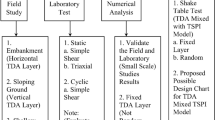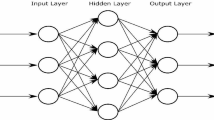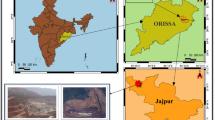Abstract
Blasting, which is widely used in hard rock mining, construction, and quarrying, can have a considerable impact on the surrounding environment. The intensity of the blast-induced ground vibration is affected by parameters such as the physical and mechanical properties of the rock mass, characteristics of the explosive, and the blasting design. The rock characteristics can change greatly from field to field or from one part of a bench to another part, and can have directional variability according to discontinuities in the geological formation and structure. In this study, field measurements were carried out and their results were evaluated to determine blast-induced ground vibrations at the Eti Mine Tülü Boron Mining Facility, Turkey. Our results showed different field constants for the propagating blast vibrations depending on the direction of propagation (K = 211.25–3,671.13 and β = 1.04–1.90) and the damping behavior of the particle velocity. Additionally, we found that the field constants decrease as the rock mass rating (%) values diminishes. A much higher correlation coefficient (R 2 = 0. 95) between the predicted and measured peak particle velocity (PPV) values was achieved for our modeling studies for PPV prediction using artificial neural networks compared with classical evaluation methods.











Similar content being viewed by others
References
Ak H (2006) The investigation of directional changes of the blast-induced ground vibration. Dissertation, Eskisehir Osmangazi University, Eskişehir (in Turkish)
Aldaş GGU (2002) Effect of some rock mass properties on blasting induced ground vibration wave characteristics at Orhaneli surface coal mine. Dissertation, Middle East Technical University, Ankara, Turkey
Alvarez-Vigil AE, Gonzalez-Nicieza C, Gayarre Lopez F, Alvarez-Fernandez MI (2012) Predicting blasting propagation velocity and vibration frequency using artificial neural network. Int J Rock Mech Min Sci 55:108–116
Ambraseys NR, Hendron AJ (1968) Dynamic behavior of rock masses, rock mechanics in engineering practices. Wiley, London
Amnieh HB, Mozdianfard MR, Siamaki A (2010) Predicting of blasting vibrations in sarcheshmeh copper mine by neural network. Saf Sci 48:319–325
Arpaz E (2000) Monitoring and evaluation of blast induced vibrations in some open-pit mines in Turkey. Dissertation, Cumhuriyet University, Sivas (in Turkish)
Arpaz E, Uysal Ö, Tola Y, Görgülü K, Çavuş M (2012) Comparison of blast-induced ground vibration predictors in Seyitomer coal mine. In: 12th Rock Mechanics Symp, Beijing, China, 18-21 October 2011, pp 1161–1163
Bieniawski ZT (1989) Engineering rock mass classifications. Wiley, London
Blair DP, Spathis AT (1982) Attenuation of explosion-generated pulse in rock masses. J Geophys Res 87(5):3885–3892
Davies B, Farmer IW, Attewell PB (1964) Ground vibrations from shallow sub-surface blasts. The Engineer 217:553–9
Demuth H, Beale M, Hagan M (2007) Neural Network Toolbox 5 user’s guide. The MathWorks, Inc., Natick
Duvall WI, Petkof B (1959) Spherical propagation of explosion generated strain pulses in rock. Report of Investigation. US Bureau of Mines, Pittsburgh, pp 5483–5521
Fausett L (1994) Fundamentals of neural networks. Prentice Hall, Englewood Cliffs
Fine TL (1999) Feedforward neural network methodology. Springer, New York
Ghosh A, Daemen JK (1983) A simple new blast vibration predictor. In: Proceedings of the 24th US Symp on Rock Mechanics, College Station, TX, USA, pp 151–61
Gupta RN, Roy PP, Bagachi A, Singh B (1987) Dynamic effects in various rock mass and their predictions. J Mines Met Fuels 35(11):455–462
Gupta RN, Roy PP, Singh B (1988) On a blast induced blast vibration predictor for efficient blasting. Proc 22nd Int Conf of Safety in Mines, Beijing, China, 2–6 Nov 1987, pp 1015–1021
Gurney K (1997) An introduction to neural networks. CRC, Boca Raton
Hagan TN (1973) Rock breakage by explosives. In: Proc Natl Symp on Rock Fragmentation, Adelaide, Australia, 26–28 Feb 1973, pp 1–17
Helvacı C, Alaca O (1991) Geology and mineralogy of the bigadiç borate deposits and vicinity. Mineral Res Expl Bull 113:31–63
ISI (1973) Criteria for safety and design of structures subjected to underground blast. ISI Bull 6922
ISRM (1992) Suggested method for blast vibration monitoring. Int J Rock Mech Mining Sci Geo Abs 29:143–156
Jimeno CL, Jimeno EL, Carcedo FJA (1995) Drilling and blasting of rocks. A.A. Balkema, Rotterdam, p 390
Kamali M, Ataei M (2010) Prediction of blast induced ground vibrations in Karoun III power plant and dam: a neural network. J S Afr Inst Min Metall 110:481–490
Khandelwal M, Singh TN (2006) Prediction of blast induced ground vibrations and frequency in opencast mine. A neural network approach. J Sound Vib 289:711–725
Khandelwal M, Singh TN (2009) Prediction of blast-induced ground vibration using artificial neural network. Int J Rock Mech Min Sci 46:1214–1222
Langefors U, Kihlström B (1978) The modern technique of rock blasting, 3rd edn. Stockholm, Sweden
Mohamed MT (2009) Artificial neural network for prediction and control of blasting vibrations in assiut (Egypt) limestone quarry. Int J Rock Mech Min Sci 46:426–431
Monjezi M, Amiri H, Farrokhi A, Goshtasbi K (2010) Prediction of rock fragmentation due to blasting in sarcheshmeh copper mine using artificial neural networks. Geotech Geol Eng 28:423–430
Nicholls HR, Johnson CF, Duvall WI (1971) Blasting vibrations and their effects on structures. USBM Bull 656
Pal RP (2005) Rock blasting. IBH, New Delhi
Roy PP (1991) Vibration control in an opencast mine based on improved blast vibration predictors. Min Sci Technol 12:157–165
Wiss JF, Linehan PW (1978) Control of vibration and air noise from surface coal mines III. USBM Rep 103(3)–79:623
Acknowledgments
This study was supported by TÜBİTAK (The Science and Technological Research Council of Turkey), Project No. 110M294. The authors would also like to thank the staff of Eti Mine for their assistance during the field work.
Author information
Authors and Affiliations
Corresponding author
Rights and permissions
About this article
Cite this article
Görgülü, K., Arpaz, E., Demirci, A. et al. Investigation of blast-induced ground vibrations in the Tülü boron open pit mine. Bull Eng Geol Environ 72, 555–564 (2013). https://doi.org/10.1007/s10064-013-0521-4
Received:
Accepted:
Published:
Issue Date:
DOI: https://doi.org/10.1007/s10064-013-0521-4




